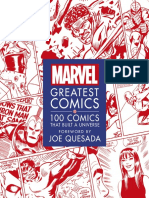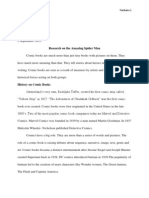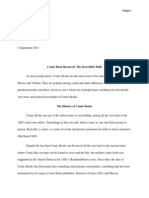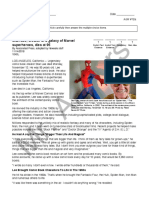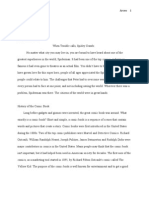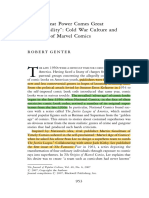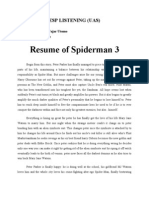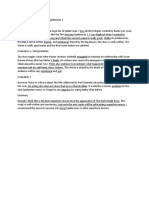Creation and Development
Creation and Development
Uploaded by
GomathiRachakondaCopyright:
Available Formats
Creation and Development
Creation and Development
Uploaded by
GomathiRachakondaOriginal Description:
Copyright
Available Formats
Share this document
Did you find this document useful?
Is this content inappropriate?
Copyright:
Available Formats
Creation and Development
Creation and Development
Uploaded by
GomathiRachakondaCopyright:
Available Formats
Creation and development
Richard Wentworth a.k.a. the Spiderin the pulp magazine The Spider. Stan Lee stated that it was the
name of this character that inspired him to create a character that would become Spider-Man.
[7]
In 1962, with the success of the Fantastic Four, Marvel Comics editor and head
writer Stan Lee was casting about for a new superhero idea. He said the idea for Spider-
Man arose from a surge in teenage demand for comic books, and the desire to create a
character with whom teens could identify.
[8]:1
In his autobiography, Lee cites the non-
superhuman pulp magazine crime fighter the Spider (see also The Spider's
Web and The Spider Returns) as a great influence,
[7]:130
and in a multitude of print and
video interviews, Lee stated he was further inspired by seeing a spider climb up a wall
adding in his autobiography that he has told that story so often he has become unsure of
whether or not this is true.
[note 1]
Looking back on the creation of Spider-Man, 1990s
Marvel editor-in-chief Tom DeFalco stated he did not believe that Spider-Man would
have been given a chance in today's comics world, where new characters are vetted
with test audiences and marketers.
[8]:9
At that time, however, Lee had to get only the
consent of Marvel publisher Martin Goodman for the character's approval.
[8]:9
In a 1986
interview, Lee described in detail his arguments to overcome Goodman's objections.
[note
2]
Goodman eventually agreed to a Spider-Man tryout in what Lee in numerous
interviews recalled as what would be the final issue of the science-fiction and
supernatural anthology series Amazing Adult Fantasy, which was renamed Amazing
Fantasy for that single issue, #15 (cover-dated August 1962, on sale June 5,
1962).
[9]
While this was indeed the final issue, its editorial page anticipated the comic
continuing and that "The Spiderman [sic] ... will appear every month in Amazing."
[9][10]
Regardless, Lee received Goodman's approval for the name Spider-Man and the
"ordinary teen" concept, and approached artist Jack Kirby. As comics historian Greg
Theakston recounts, Kirby told Lee about an unpublished character on which he had
collaborated with Joe Simon in the 1950s, in which an orphaned boy living with an old
couple finds a magic ring that granted him superhuman powers. Lee and Kirby
"immediately sat down for a story conference", Theakston writes, and Lee afterward
directed Kirby to flesh out the character and draw some pages.
[11]
Steve Ditko would be
the inker.
[note 3]
When Kirby showed Lee the first six pages, Lee recalled, "I hated the way
he was doing it! Not that he did it badlyit just wasn't the character I wanted; it was too
heroic".
[11]:12
Lee turned to Ditko, who developed a visual style Lee found satisfactory.
You might also like
- Marvel Greatest Comics 100 Comics That Built A UniverseDocument256 pagesMarvel Greatest Comics 100 Comics That Built A UniverseSeason Seaman100% (7)
- Spiderman Comic BookDocument9 pagesSpiderman Comic Bookapi-2350867400% (1)
- Stephen KingDocument2 pagesStephen KingIulia100% (1)
- Weeeeeeeee: Fantastic Four Stan LeeDocument2 pagesWeeeeeeeee: Fantastic Four Stan Leeabdul qayyumNo ratings yet
- Fantastic Four Stan LeeDocument2 pagesFantastic Four Stan Leeabdul qayyumNo ratings yet
- Thurkey SpiderDocument3 pagesThurkey Spiderabdul qayyumNo ratings yet
- Fantastic Four Stan Lee: Amazing FantasyDocument1 pageFantastic Four Stan Lee: Amazing FantasyMarius AndreiNo ratings yet
- Julianna Comic Book ResearchDocument7 pagesJulianna Comic Book Researchapi-235260730No ratings yet
- Spiderman Essay ReviseDocument7 pagesSpiderman Essay Reviseapi-235273521No ratings yet
- The Independent - Jack KirbyDocument3 pagesThe Independent - Jack KirbyJago100% (1)
- Spidey RebuttalDocument40 pagesSpidey RebuttalbmwscribdNo ratings yet
- Engl1010 ResearchpaperDocument7 pagesEngl1010 Researchpaperapi-344328103No ratings yet
- Document 3Document1 pageDocument 3fsdfdsNo ratings yet
- Comic BookDocument5 pagesComic Bookapi-235260388No ratings yet
- Christian Rodriguez RevisedDocument6 pagesChristian Rodriguez Revisedapi-235361659No ratings yet
- Comic Book PaperDocument8 pagesComic Book Paperapi-235361838No ratings yet
- Research PaperDocument6 pagesResearch Paperapi-235273688No ratings yet
- Stan Lee The Creator: Made by Yana Trompak and Nastia RezvanovaDocument12 pagesStan Lee The Creator: Made by Yana Trompak and Nastia RezvanovaЯна ТромпакNo ratings yet
- SpidermanDocument11 pagesSpidermanapi-235264861No ratings yet
- Batman RPDocument8 pagesBatman RPapi-235534132No ratings yet
- JawoodDocument6 pagesJawoodapi-235277628No ratings yet
- Leslie Cuevas Comic BookDocument8 pagesLeslie Cuevas Comic Bookapi-235273703No ratings yet
- Superman: The Silver Age Newspaper Dailies, Vol. 2 PreviewDocument19 pagesSuperman: The Silver Age Newspaper Dailies, Vol. 2 PreviewGraphic Policy100% (4)
- Comic Book EssayDocument7 pagesComic Book Essayapi-235260348No ratings yet
- Otto - Binder Resumen de Wiki (Documento Sin Caracter Comercial Es Una Recopilacion de Informacion)Document10 pagesOtto - Binder Resumen de Wiki (Documento Sin Caracter Comercial Es Una Recopilacion de Informacion)Pedro Felipe Moreno CarvajalNo ratings yet
- Spider ManDocument4 pagesSpider ManPew FaceNo ratings yet
- Otto Binder: The Life and Work of a Comic Book and Science Fiction VisionaryFrom EverandOtto Binder: The Life and Work of a Comic Book and Science Fiction VisionaryRating: 4 out of 5 stars4/5 (2)
- Amazing Fantasy: Pider-Man Is A FictionalDocument1 pageAmazing Fantasy: Pider-Man Is A Fictionalabdul qayyumNo ratings yet
- Spiderman SH WpsDocument3 pagesSpiderman SH Wpsapi-235349959No ratings yet
- Spider-Man Michelle Leyva p5Document7 pagesSpider-Man Michelle Leyva p5api-235072194No ratings yet
- Tessa Hensley Spider-Man Research PaperDocument7 pagesTessa Hensley Spider-Man Research Paperapi-235265033No ratings yet
- Stan Lee Bib - Proc PDFDocument27 pagesStan Lee Bib - Proc PDFErick CruzNo ratings yet
- Enter Stan Lee: Chapter TwoDocument30 pagesEnter Stan Lee: Chapter TwoSamsonSavageNo ratings yet
- Stan Lee, Creator of A Galaxy of Marvel Superheroes, Dies at 95Document4 pagesStan Lee, Creator of A Galaxy of Marvel Superheroes, Dies at 95Ntumba NtumbaNo ratings yet
- Bat ManDocument1 pageBat ManSPORTLIVENo ratings yet
- Comic DiagnosticDocument2 pagesComic Diagnosticapi-180483553No ratings yet
- SpiderDocument2 pagesSpiderCris LuNo ratings yet
- Amazing Fantasy: Spider-Man Is A FictionalDocument2 pagesAmazing Fantasy: Spider-Man Is A FictionalRengie GaloNo ratings yet
- Amazing Fantasy: Dwawwwwwwwwwwwwwwwwwpider-Man Is A FictionalDocument1 pageAmazing Fantasy: Dwawwwwwwwwwwwwwwwwwpider-Man Is A Fictionalabdul qayyumNo ratings yet
- Super ManDocument2 pagesSuper ManVieru VasileNo ratings yet
- Spiderman EssayDocument7 pagesSpiderman Essayapi-235303707No ratings yet
- Comic Book EssayDocument7 pagesComic Book Essayapi-235085474No ratings yet
- Archie ComicsDocument10 pagesArchie ComicsbillyNo ratings yet
- LIFE Rise of the Superhero: From the Golden Age to the Silver ScreenFrom EverandLIFE Rise of the Superhero: From the Golden Age to the Silver ScreenRating: 5 out of 5 stars5/5 (1)
- BatmanDocument6 pagesBatmanapi-236535544No ratings yet
- Complete Tribute Stan LeeDocument10 pagesComplete Tribute Stan LeeFactorNo ratings yet
- Final Comic Book PaperDocument5 pagesFinal Comic Book Paperapi-235357065No ratings yet
- Superhero ConclaveDocument21 pagesSuperhero Conclaveharshvardhanrathore10000000No ratings yet
- Avengers Infinity WarDocument6 pagesAvengers Infinity WarAbhirup SarkarNo ratings yet
- Dread End PDFDocument13 pagesDread End PDFRuxandra Zaharia100% (3)
- Was Superman a Spy?: And Other Comic Book Legends RevealedFrom EverandWas Superman a Spy?: And Other Comic Book Legends RevealedRating: 3.5 out of 5 stars3.5/5 (29)
- DocumentDocument2 pagesDocumentAnimation starNo ratings yet
- SpidermanDocument1 pageSpidermanpranjal varshneyNo ratings yet
- Marvel Comics: VampirellaDocument3 pagesMarvel Comics: VampirellaYouShall NotWatchNo ratings yet
- Frankenstein Dr. Jekyll and Mr. Hyde: Cover Dated Penciled Inked Paul ReinmanDocument4 pagesFrankenstein Dr. Jekyll and Mr. Hyde: Cover Dated Penciled Inked Paul ReinmanRengie GaloNo ratings yet
- Joe Simon Crestwood Publications: (Note 4)Document1 pageJoe Simon Crestwood Publications: (Note 4)Marius AndreiNo ratings yet
- Stan Lee,: Relaionship With WifeDocument9 pagesStan Lee,: Relaionship With Wifefan maitriNo ratings yet
- Stan LeeDocument10 pagesStan Leeapi-267852658No ratings yet
- SpidermanDocument1 pageSpidermanAbhi Welcomes UNo ratings yet
- Businessweek: Mister Fantastic (Reed Richards) Is ADocument1 pageBusinessweek: Mister Fantastic (Reed Richards) Is AGomathiRachakondaNo ratings yet
- Spider-Man: "Peter Parker" Redirects Here. For Other Uses, See andDocument3 pagesSpider-Man: "Peter Parker" Redirects Here. For Other Uses, See andGomathiRachakondaNo ratings yet
- Syn. Flowering Plant Europe Asia North America Australia New Zealand AsteraceaeDocument1 pageSyn. Flowering Plant Europe Asia North America Australia New Zealand AsteraceaeGomathiRachakondaNo ratings yet
- Ian FelmingDocument1 pageIan FelmingGomathiRachakondaNo ratings yet
- Peruvian PepperDocument1 pagePeruvian PepperGomathiRachakondaNo ratings yet
- Cheese Buns, Cheese Breads, Pão de Queijo or Chipá Are A Variety of Small, Baked, CheeseDocument1 pageCheese Buns, Cheese Breads, Pão de Queijo or Chipá Are A Variety of Small, Baked, CheeseGomathiRachakondaNo ratings yet
- White Blood Cells (WBCS), Also Called Leukocytes or Leucocytes, Are The Cells of The ImmuneDocument1 pageWhite Blood Cells (WBCS), Also Called Leukocytes or Leucocytes, Are The Cells of The ImmuneGomathiRachakondaNo ratings yet
- Green Pepper: Sulfur Dioxide Canning Freeze-Drying Brine Vinegar Asian Cuisines Thai CuisineDocument1 pageGreen Pepper: Sulfur Dioxide Canning Freeze-Drying Brine Vinegar Asian Cuisines Thai CuisineGomathiRachakondaNo ratings yet
- LeukemiaDocument1 pageLeukemiaGomathiRachakondaNo ratings yet
- Gappa Ke Bataashe, Marathi:: (Help Info)Document1 pageGappa Ke Bataashe, Marathi:: (Help Info)GomathiRachakondaNo ratings yet
- Chemotherapy (Often Abbreviated To Chemo and Sometimes CTX or CTX) Is The TreatmentDocument1 pageChemotherapy (Often Abbreviated To Chemo and Sometimes CTX or CTX) Is The TreatmentGomathiRachakondaNo ratings yet
- Pepper Plant With Immature PeppercornsDocument2 pagesPepper Plant With Immature PeppercornsGomathiRachakondaNo ratings yet
- Lilium (Members of Which Are True Lilies) Is A Genus of Herbaceous Flowering Plants Growing FromDocument1 pageLilium (Members of Which Are True Lilies) Is A Genus of Herbaceous Flowering Plants Growing FromGomathiRachakondaNo ratings yet
- Tapioca (: Portuguese PronunciationDocument1 pageTapioca (: Portuguese PronunciationGomathiRachakondaNo ratings yet
- Culinary UsesDocument1 pageCulinary UsesGomathiRachakondaNo ratings yet
- Species Flowering Plant Family Native Evergreen Shrub: Crossandra Infundibuliformis (Firecracker Flower), Is ADocument1 pageSpecies Flowering Plant Family Native Evergreen Shrub: Crossandra Infundibuliformis (Firecracker Flower), Is AGomathiRachakondaNo ratings yet
- Prostate Cancer Is A Form ofDocument1 pageProstate Cancer Is A Form ofGomathiRachakondaNo ratings yet
- Onion PakodaDocument2 pagesOnion PakodaGomathiRachakondaNo ratings yet
- Vulpes: Fox Is A Common Name For Many Species of Alert OmnivorousDocument1 pageVulpes: Fox Is A Common Name For Many Species of Alert OmnivorousGomathiRachakondaNo ratings yet
- Order Family Aquatic Flightless Birds Southern Hemisphere Antarctica Countershaded Flippers Krill Fish Squid SealifeDocument1 pageOrder Family Aquatic Flightless Birds Southern Hemisphere Antarctica Countershaded Flippers Krill Fish Squid SealifeGomathiRachakondaNo ratings yet
- HT UnderDocument3 pagesHT UnderGomathiRachakondaNo ratings yet
- Bear Because The Grizzly and The Brown Bear Are One Species On Two ContinentsDocument1 pageBear Because The Grizzly and The Brown Bear Are One Species On Two ContinentsGomathiRachakondaNo ratings yet
- Carnivorous Bear Arctic Circle: Ursus MaritimusDocument1 pageCarnivorous Bear Arctic Circle: Ursus MaritimusGomathiRachakondaNo ratings yet
- WolfDocument1 pageWolfGomathiRachakondaNo ratings yet
- Spider-Man: T A B T A BDocument2 pagesSpider-Man: T A B T A BManuel A. ColquiNo ratings yet
- Spider-Man 4 Script TreatmentDocument38 pagesSpider-Man 4 Script TreatmentRobert CinemaNo ratings yet
- Materi Review TexjjbvvhjDocument4 pagesMateri Review TexjjbvvhjHafied CreedNo ratings yet
- Annotated-Annotated Bib SampleDocument3 pagesAnnotated-Annotated Bib SampleEric GeorgeNo ratings yet
- Thesis and PointDocument3 pagesThesis and PointNicole DaleskaNo ratings yet
- Practice Test For Grade 7Document3 pagesPractice Test For Grade 7Đức Minh NguyễnNo ratings yet
- Marvel ComicsDocument26 pagesMarvel ComicsSoumyaNo ratings yet
- MH001-Rulebook EN Web PDFDocument16 pagesMH001-Rulebook EN Web PDFMarcelo Limarino LòpezNo ratings yet
- A Sad Little SpiderDocument6 pagesA Sad Little SpiderIsabelle Thacker (izzy)No ratings yet
- Spider Geddon Reading OrderDocument3 pagesSpider Geddon Reading OrderPunyam SinghNo ratings yet
- The Militarization of Marvel's Avengers Brett PardyDocument21 pagesThe Militarization of Marvel's Avengers Brett PardyGading PratamaNo ratings yet
- Spectacular Spider-Man v1 002Document25 pagesSpectacular Spider-Man v1 002ghasankitanaNo ratings yet
- Spiderman (Peter Parker)Document2 pagesSpiderman (Peter Parker)KevinNo ratings yet
- Fixing Madame Web_Document136 pagesFixing Madame Web_danramsan87No ratings yet
- Grammar and Vocabulary TestDocument7 pagesGrammar and Vocabulary TestjelenabogdanNo ratings yet
- Spider-Man 4 (Treatment)Document5 pagesSpider-Man 4 (Treatment)Shinbiore LirhyamNo ratings yet
- Long and Short Essays On Spiderman For Students and Kids in EnglishDocument4 pagesLong and Short Essays On Spiderman For Students and Kids in EnglishJohn DoeNo ratings yet
- BackIssue48Preview PDFDocument21 pagesBackIssue48Preview PDFrossparkNo ratings yet
- 1.2.1 Responsibilities of A Project Manager - AR 503-ARCH52S1 - Project ManagementDocument3 pages1.2.1 Responsibilities of A Project Manager - AR 503-ARCH52S1 - Project ManagementJCLLNo ratings yet
- Screenwriting - English Creative WritingDocument11 pagesScreenwriting - English Creative Writingkhoirunnisa filjanahNo ratings yet
- Jackkirby PDFDocument34 pagesJackkirby PDFphotoimation100% (6)
- Spiderman 3Document3 pagesSpiderman 3Galang Fajar Utomo0% (1)
- TDVH bIE6 E79i Ika9 Gtyb bEX7 1335 htV1 XG9Z fDUk zSs8 4t60 MuDocument9 pagesTDVH bIE6 E79i Ika9 Gtyb bEX7 1335 htV1 XG9Z fDUk zSs8 4t60 MuNovi YantiNo ratings yet
- What's So FunnyDocument3 pagesWhat's So FunnyGustavo SouzaNo ratings yet
- Spider Man Drawing - Google SearchDocument1 pageSpider Man Drawing - Google Searchmia watsonNo ratings yet
- 4 - Swot and Pest RepurposedDocument1 page4 - Swot and Pest Repurposedapi-576207178No ratings yet
- Review TextDocument2 pagesReview Textphilipus juan PabloNo ratings yet
- MMRPG 1.3 Character Profiles Update 112122Document19 pagesMMRPG 1.3 Character Profiles Update 112122Cadmo mescolottoNo ratings yet
- SyfgeygferufgeDocument26 pagesSyfgeygferufgeyoavserganiNo ratings yet
